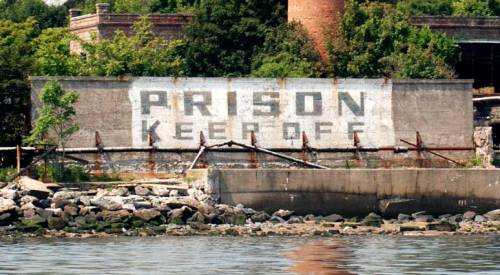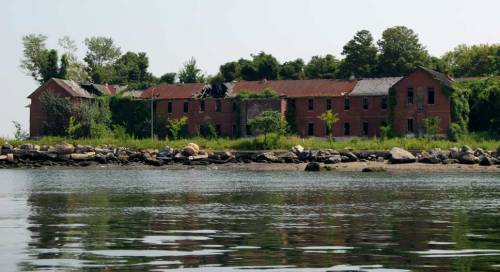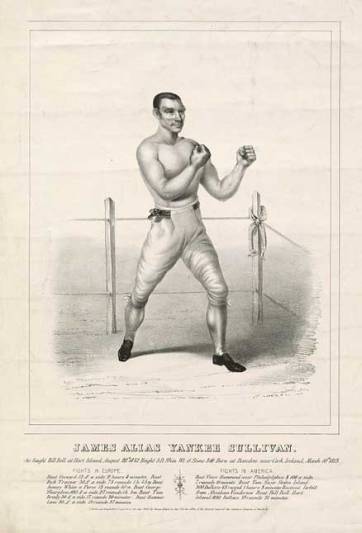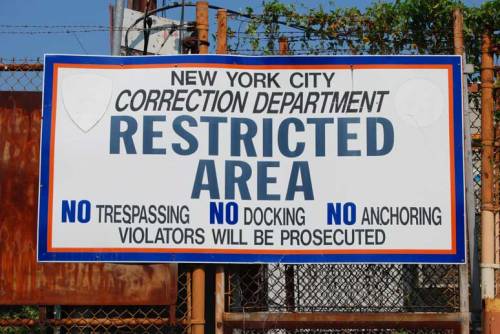
Location: Northeast Bronx
Status: Active Prison
At northernmost tip of the Bronx an uninhabited island conceals the bodies of over one million lost souls. Known as Hart Island, the mile long rock served as a prison and burial ground stretching back to the Civil War.
Situated at the perilous junction of the East River and the Long Island Sound, Harts Island juts out into the mouth of a treacherous nautical passageway known as Hellgate. Known for its swirling currents and jagged rock formations, the waterway ranks as one of the world’s most perilous shipping lanes. The swift current and isolation made the island a choice location for nefarious behavior in early New York.

Ruins on Hart Island, a NYC prison and potter’s field.
Bare Knuckle Boxing Island
By the mid 1800s, Hart Island became a prime tourist destination for every rogue and scoundrel in town when City officials banned boxing. Overnight, the ban turned the island into one of New York’s première pugilism venues.
On April 20, 1842, James “Yankee” Sullivan and Englishman Billy Bell slugged it out for 24 bloody bare-knuckle rounds. Over 6,000 fans, including Yankee Sullivan’s pal Bill the Butcher Poole, sailed to the island to cheer on Sullivan. One newspaper joked that the city’s crime rate went down that day. The New York Daily Express commented:
“A gang of loafers and rowdies went out of the city yesterday to see a fisticuffins.” –The New York Daily Express, 1842

Yankee Sullivan, a close friend of Bill The Butcher Poole, boxed on Hart Island
With a flourish of lefts, rights and hooks, Yankee Sullivan pummeled Bell and took home the $300 prize. By the time of the Civil War, fighters regularly battled on this desolate stretch of land, but the Union spoiled the fun when they realized the island’s usefulness following a rash of professional bounty jumping, the City’s newest crimewave.
Bounty Jumpers
During the Civil War draft of 1863, the wealthy could pay a bounty for someone to fight in their place. Criminals, known as bounty jumpers, moved in on practice, signing up to fight, collecting the payment, and then disappearing only to sign up for another bounty.
To contain the bounty jumpers, New York’s Provost Marshal purchased Hart island for $75,000 and transformed the island into an inescapable bootcamp. Over 50,000 troops were trained on the site. Over the next few years, units from all over the eastern seaboard mustered in the escape proof military base.
Civil War Prison
By 1864, General Henry Wessels, the provost marshal commanding the atoll, advocated the use of the island as a prisoner of war camp. In April of 1865, the Union crammed the worst confederate scoundrels onto the northern tip of the island. A stout twelve-foot stockade and roving boat patrols kept escapes to a minimum, and only four POWs attempted to make a swim for freedom. By the end of the month, the Civil War ended and over 3,000 prisoners were jammed into four tiny yards that slept two and three to a bed.

Civil War ruins on Hart Island surrounded by barbed wire.
Predictably, cholera erupted and swept through the camp killing seven percent of its population. Civil War historians generally agree that the site was the Union’s last and worst prison camp. Following the conclusion of hostilities, many Confederates lingered on the island for months after the war until they swore an oath of allegiance.

City Jail and Potter’s Field
After the war, New York City purchased the island in 1869 for $75,000 and converted the camp into a city jail and a potter’s field for the burial of individuals who could not afford a proper funeral. The phrase potter’s field derives from Matthew 27:3-8 in the New Testament. The Bible states,
“It is not right to deposit this in the temple treasury since it is blood money. After consultation, they used it to buy the potter’s field as a cemetery for foreigners.”–Matthew 27:3-8
Since the 1869, correction officials have shuttled convicts from Blackwell’s Island and later Rikers Island to City Island in the Bronx where the prisoners board a ferry that would transport them to the island of the dead. Hart Island remains an active prison and burial ground until this day, and the prisoners still carry out the ghoulish work for 30 cents an hour.

Hart Island is an active NYC prison. Prisoners named the Ghoul Squad bury bodies in mass graves.

